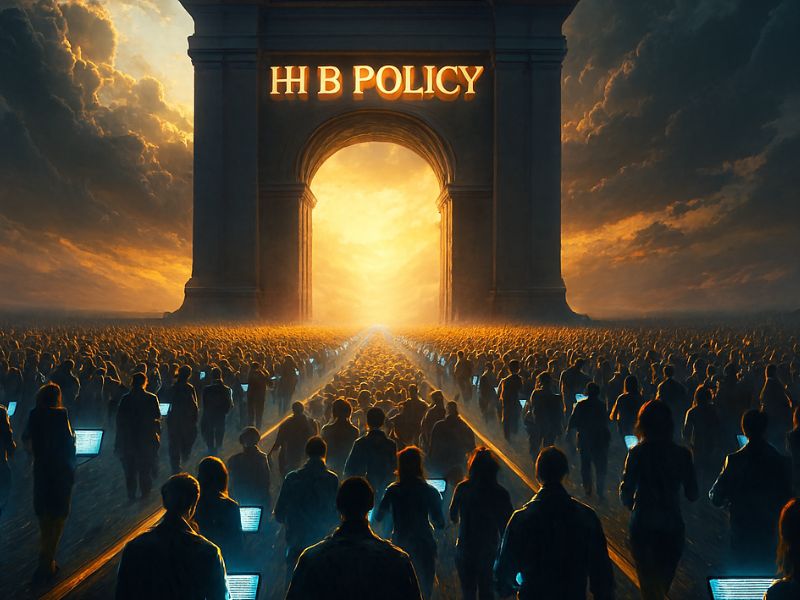The recent H1B visa policy changes have created a major shift in the tech industry, impacting hiring strategies, talent flow, and the business models of companies that rely on a global workforce. The most significant change is the introduction of a new, substantial fee for H1B visas. This policy is forcing both large tech giants and smaller startups to rethink how they acquire and retain talent, leading to a ripple effect across the U.S. and global economies.
1. The New Reality: A $100,000 Fee is a Game-Changer

In a major policy move, the US administration has signed a proclamation imposing a $100,000 H1B visa fee for companies bringing foreign workers into the country. This fee is in addition to the existing H1B visa fees, which typically range from a few thousand to ten thousand dollars. The new rule, effective September 21, 2025, is a direct challenge to the business models of many companies, particularly those in the IT outsourcing sector.
This move is intended to ensure that H1B visas are used only for “extraordinarily skilled” individuals whose expertise is not available domestically. The new fee is set at a level that proponents argue will make it economically unfeasible to hire entry-level or mid-level foreign workers at wages below what a comparable American professional would earn.
- Who is most affected? The policy change disproportionately impacts Indian professionals, who have historically been the largest group of H1B visa beneficiaries. Indian IT firms, which rely on the program to place engineers and developers in client projects in the US, face the most significant cost increases.
2. A Tale of Two Companies: Why the Impact Varies

The H1B visa policy changes are not affecting all companies equally. The impact depends largely on a company’s business model and its reliance on the H1B program for talent acquisition.
- The Big Tech Giants: Companies like Microsoft and Meta, while using the H1B program extensively, are generally hiring high-skilled professionals for specialized, well-paid roles. They can likely absorb the new costs for top-tier talent. The $100,000 H1B visa fee will be a financial burden, but it may not be a deal-breaker for hiring a world-class AI researcher or a senior-level engineer. For them, the biggest risk is a potential slowdown in innovation if they can’t access a global talent pool as easily.
- The IT Outsourcing Firms: For companies with a business model centered on providing a large volume of skilled workers for client projects, the fee is a seismic event. This includes many Indian IT giants. The new fee could make their services less competitive compared to US-based firms or even to their own onshore teams. For them, the choice is stark: either absorb the massive cost, pass it on to clients (and risk losing business), or shift their strategy entirely.
This is a classic example of how a policy designed to protect one group can create unintended consequences for others. For some, the new policy may be a manageable cost of doing business, while for others, it threatens to dismantle their entire operating model.
3. The Great Talent Rebalancing: Shifting the Global Talent Pool 🌍

For years, the U.S. has been the undisputed global destination for top tech talent. The promise of high salaries, career growth, and an innovative ecosystem has drawn millions of professionals from around the world. The new H1B visa policy changes could disrupt this long-standing dynamic and lead to a significant H1B talent pool redistribution.
- The Brain Drain Reversal: The new policy could, ironically, lead to a “brain gain” for countries like India. As it becomes harder for highly skilled professionals to work in the U.S., they may opt to stay in their home countries or look to other, more immigrant-friendly nations like Canada or the UK. This could turbocharge India’s booming startup ecosystem and tech sector, as more top-tier engineers, scientists, and tech leaders stay to build and innovate at home.
- A Focus on Domestic Talent: The policy’s intended effect is to encourage US companies to hire and train American workers. While proponents argue this will lead to a more localized and robust US workforce, critics suggest it could lead to a talent shortage in highly specialized fields where the US workforce alone cannot meet demand. The H1B visa policy changes could, in this way, force companies to invest more in domestic talent pipelines, but the question remains if this can fill the gap left by international workers.
4. A Deeper Look: The Trump H1B Overhaul Reaction

This new policy did not emerge in a vacuum. It is part of a broader Trump H1B overhaul reaction to what the administration views as “systemic abuse” of the visa program. The administration claims that the H1B visa has been used to undercut American workers’ wages and replace them with lower-paid foreign labor. The new fees and proposed reforms are a direct response to these long-held concerns.
The administration has cited cases where American workers were laid off and allegedly forced to train their foreign replacements. While the new policy aims to correct these issues, it is being met with mixed reactions.
- Supporters: Proponents of the policy, including some labor unions and political figures, argue that it will protect American jobs and prevent wage suppression. They believe the $100,000 H1B visa fee is a necessary step to ensure the integrity of the program.
- Critics: Critics, including many in the tech community and immigration advocates, argue that the fee will stifle innovation, discourage top talent from coming to the U.S., and harm the country’s long-term economic competitiveness. They argue that the policy is a blunt instrument that does not distinguish between legitimate talent and companies that misuse the system.
This policy move is not just a regulatory change; it is a major political statement with profound economic implications.
5. FAQs: Answering Your Burning Questions
Q1: Does the $100,000 fee apply to all H1B workers? A1: The new rule applies to H1B petitions for workers who are currently outside the United States and are seeking to enter. It does not apply to H1B workers who are already in the country for extensions or transfers.
Q2: What other changes are being considered besides the new fee? A2: The new policy is part of a broader overhaul. Other proposed changes include raising prevailing wage levels to prevent undercutting American salaries and prioritizing higher-paid, highly skilled foreign workers in the H1B lottery process. This means a shift from a random lottery to a wage-based system.
Q3: Will this policy be challenged in court? A3: Legal experts believe the new policy is likely to face significant legal challenges. Critics argue that the administration may have overstepped its authority by implementing such a drastic fee without congressional approval. The legal battle over the H1B visa policy changes is expected to be a long and complex one.
The Path Forward: What This Means for You
The H1B visa policy changes are more than just news; they are a sign of a new era in global talent mobility. The era of low-cost, high-volume foreign talent may be coming to an end. For companies, this means a necessary re-evaluation of hiring strategies, a greater focus on automation, and a renewed commitment to domestic talent.
For professionals, especially those in India and other countries with a high number of H1B applicants, the message is clear: the path to a U.S. tech job is about to become more difficult. It’s a time to consider diversifying your career goals, exploring opportunities in other countries, or focusing on contributing to the burgeoning tech ecosystems in your own nations.
The full impact of this policy will unfold in the coming months, but one thing is certain: the global tech industry is at a pivotal inflection point. The next few years will tell us if these changes lead to a stronger American tech sector or a more competitive global one.



